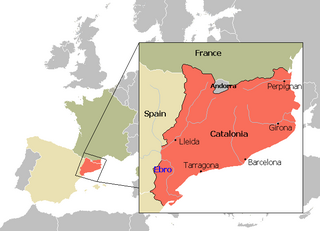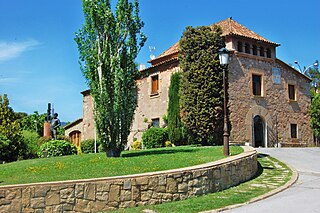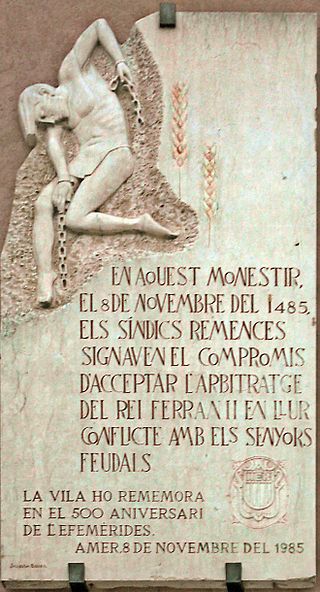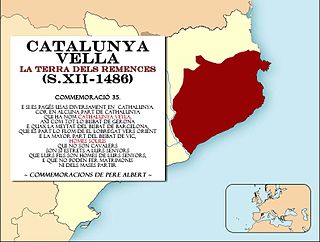
The recorded history of the lands of what today is known as Catalonia begins with the development of the Iberian peoples while several Greek colonies were established on the coast before the Roman conquest. It was the first area of Hispania conquered by the Romans. It then came under Visigothic rule after the collapse of the western part of the Roman Empire. In 718, the area was occupied by the Umayyad Caliphate and became a part of Muslim ruled al-Andalus. The Frankish Empire conquered northern half of the area from the Muslims, ending with the conquest of Barcelona in 801, as part of the creation of a larger buffer zone of Christian counties against Islamic rule historiographically known as the Marca Hispanica. In the 10th century the County of Barcelona became progressively independent from Frankish rule.

Benabarre, in Ribagorçan and Aragonese: Benavarri is a town and municipality in the Aragonese comarca of Ribagorza, in the province of Huesca, Spain.

John II, called the Great or the Faithless, was King of Aragon from 1458 until his death in 1479. As the husband of Queen Blanche I of Navarre, he was King of Navarre from 1425 to 1479. John was also King of Sicily from 1458 to 1468.

The co-princes of Andorra are jointly the heads of state of the Principality of Andorra, a landlocked microstate lying in the Pyrenees between France and Spain. Founded in 1278 by a treaty between the bishop of Urgell and the Count of Foix, this unique diarchical arrangement has persisted through the Middle Ages to the present. Currently, the bishop of Urgell and the president of France serve as Andorra's co-princes, following the transfer of the count of Foix's claims to the Crown of France and, subsequently, to the head of state of the French Republic. Each co-prince appoints a personal representative, the Bishop co-prince is currently being represented by Josep Maria Mauri and the French co-prince by Patrick Strzoda.

The Crown of Aragon was a composite monarchy ruled by one king, originated by the dynastic union of the Kingdom of Aragon and the County of Barcelona and ended as a consequence of the War of the Spanish Succession. At the height of its power in the 14th and 15th centuries, the Crown of Aragon was a thalassocracy controlling a large portion of present-day eastern Spain, parts of what is now southern France, and a Mediterranean empire which included the Balearic Islands, Sicily, Corsica, Sardinia, Malta, Southern Italy, and parts of Greece.

The Principality of Catalonia was a medieval and early modern state in the northeastern Iberian Peninsula. During most of its history it was in dynastic union with the Kingdom of Aragon, constituting together the Crown of Aragon. Between the 13th and the 18th centuries, it was bordered by the Kingdom of Aragon to the west, the Kingdom of Valencia to the south, the Kingdom of France and the feudal lordship of Andorra to the north and by the Mediterranean Sea to the east. The term Principality of Catalonia was official until the 1830s, when the Spanish government implemented the centralized provincial division, but remained in popular and informal contexts. Today, the term Principat (Principality) is used primarily to refer to the autonomous community of Catalonia in Spain, as distinct from the other Catalan Countries, and usually including the historical region of Roussillon in Southern France.

The County of Barcelona was a polity in northeastern Iberian Peninsula, originally located in the southern frontier region of the Carolingian Empire. In the 10th century, the Counts of Barcelona progressively achieved independence from Frankish rule, becoming hereditary rulers in constant warfare with the Islamic Caliphate of Córdoba and its successor states. The counts, through marriage, alliances and treaties, acquired or vassalized the other Catalan counties and extended their influence over Occitania. In 1164, the County of Barcelona entered a personal union with the Kingdom of Aragon. Thenceforward, the history of the county is subsumed within that of the Crown of Aragon, but the city of Barcelona remained preeminent within it.
The counts of Berga were the feudal lords of Berga, one of the Catalan counties created out of Besalú in 988 for a younger son of Oliba Cabreta. The viscounts of Berga ruled the city in name during the rule of the counts of Besalú from the early tenth century.

Maria of Castile was Queen of Aragon and Naples as the spouse of Alfonso V of Aragon. Maria acted twice as the regent of Aragon during the reign of her spouse, as he was absent during most of his reign; those regencies lasted between 1420 and 1423 and between 1432 and 1458. She was also briefly Princess of Asturias in her own right as the heiress presumptive to the throne of Castile. She succeeded her father, Henry III of Castile, as Princess of Asturias in 1402.

The Llibre dels fets is the autobiographical chronicle of the reign of James I of Aragon (1213–1276). It is written in Old Catalan in the first person and is the first chronologically of the four works classified as The Four Great Catalan Chronicles, all belonging to the early medieval Crown of Aragon, and its first royal dynasty, the House of Barcelona. James I inherited as a child the titles of King of Aragon, Count of Barcelona, and Lord of Montpellier, but also became by conquest King of Majorca and King of Valencia. James emphasises in his chronicles his conquest of Majorca (1229) and of Valencia (1238).

PereTomich or Tomic was a Catalan knight and historian. He was son of the mayor of Bagà and attorney for the baronies of Pinós and Mataplana. He was Castilian of the castle of Aristot in the years 1446-47.

The Liber feudorum Ceritaniae is, as its Latin title indicates, a book registering the fiefs (feudi) within the counties of Cerdagne (Ceritania), Roussillon and Conflent, and the feudal obligations of the count and his vassals. It is preserved in the Arxiu de la Corona d'Aragó and consists of 272 charters in 379 folios with 32 colourful miniatures on a golden background. It was probably originally copied from a part of the Liber feudorum maior (LFM), which is several decades older. It contains all the documents pertaining to Cerdagne and Roussillon found in the LFM and in exactly the same order, as well as six documents more. Most of the charters in it cover the years 1172–6.

Les Tres Torres is a residential neighbourhood in the inland Sarrià-Sant Gervasi district of Barcelona, Catalonia (Spain).

The House of Entença was an ancient and noble dynasty of the Crown of Aragon.

A masia in Catalan is a type of rural construction common to the east of Spain: Catalonia, Valencian Community, Aragon, Languedoc and Provence. The estate in which the masia is located is called a mas. They are often large but isolated structures, nearly always associated with a family farming or livestock operation.

The House of Montcada is an aristocratic and noble Spanish Catalan House with important ramifications in Sicily. Queen Elisenda of the Crown of Aragon was a member of the family.

The History of the Catalan Navy is a book written by Arcadi García Sanz that glosses the Catalan Navy, in trade and war, its exploits and conquests, in a historical compilation that covers from Prehistory to this day. It describes the maritime battles, the Catalan sea consulates, to end by detailing aspects of maritime law, being the author a lawyer.

The Sentencia Arbitral de Guadalupe was a legal decree delivered by King Ferdinand II of Aragon at the Monastery of Santa María de Guadalupe in Extremadura, Spain on 21 April 1486 to free the Catalan remensa peasants who were subjects of the lord of the manor and tied to his lands and subject to numerous onerous fees and maltreatment under the so-called evil customs.

Old Catalonia was a legal concept created by Catalan jurist Pere Albert in the second quarter of the thirteenth century to refer to the territories of Catalonia containing remensa peasants from the Diocese of Girona, the eastern half of the Diocese of Vic and the portion of the Archdiocese of Barcelona east of the Llobregat river.

The Spanish institutions of the Ancien Régime were the superstructure that, with some innovations, but above all through the adaptation and transformation of the political, social and economic institutions and practices pre-existing in the different Christian kingdoms of the Iberian Peninsula in the Late Middle Ages, presided over the historical period that broadly coincides with the Modern Age: from the Catholic Monarchs to the Liberal Revolution and which was characterized by the features of the Ancien Régime in Western Europe: a strong monarchy, a estamental society and an economy in transition from feudalism to capitalism.


















